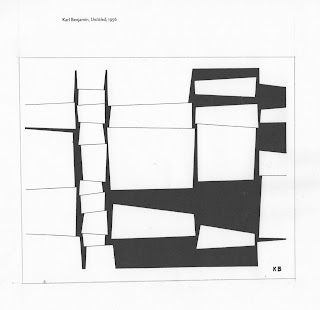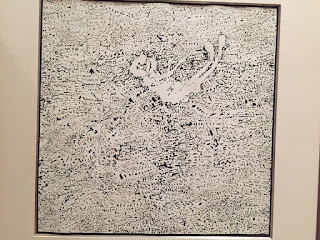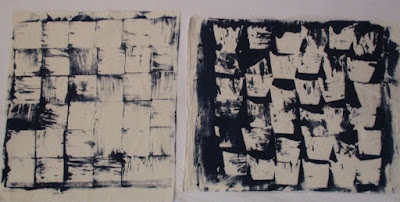I will be taking a week-long workshop with
Claire Benn in early October on "Lines and Rows: Rhythm and Repetition." Claire describes the aim of the workshop: "to focus in on the power of the repetitive mark, building lines and rows to create cloth that has rhythm and simplicity." This will be a chance to followup on work I did with Claire in
2014 (which led to my
Accident II quilt) and also work I did with Dorothy Caldwell in
2013. Claire asked participants to prepare ahead in various ways, including laying out 100 of the same thing in lines or a grid, looking for pattern everywhere, and narrowing one's focus to a small number of types of marks/shapes of interest. I've spent the last few weeks, since the close of my show, working on this, and look forward to developing ideas further at the workshop. I have a humble goal in mind, which is to make fabric that I can then turn into table napkins. I've long made napkins for our own use at home, and also as gifts for others, but have made them from commercial fabrics. A few years ago, I made some from
Marcia Derse's beautiful fabric, which is commercially produced but based on her hand-dyed/painted fabric. I have been wanting to come up with some designs that would work for making my own fabric, and Claire's workshop gives me that opportunity.
I made the design at the top by cutting up black construction paper. The idea for the design came from a drawing by Karl Benjamin:

I am entranced by this drawing--something very appealing to me about the piled up block shapes. I pulled out one column of the blocks, changed them from white to black, and increased the space between the blocks. Multiplying the columns, changing the order in some columns:
This is still very close to the Benjamin drawing--too close for me to feel comfortable using it--so I decided to try the same idea with triangles, and came up with the design at the top of the post, which I will enjoy playing with more. I'll also do some trials with wedge-shapes. Here's a postcard I made some years ago, but never sent because I like it too much:
I got another interesting shape by manipulating a photograph in Photoshop. Here's the photo, which was a collection of 100 blossoms from a chestnut tree:
Through cropping and various manipulations, I came up with this:
I collected 100 examples of several things, but my favorite was pine needles. Here are a few different arrangements of 100 needles. So much potential here for beautiful line drawings! Another option is to turn one or more of the photos into a thermofax screen, which could be used directly for printing. (You can double-click on photos to see them larger.)
Another direction is to work from the lovely lines of the piece below, made by free-motion stitching with a variegated thread that changed in color from black to white--hence the "missing" spaces in the design. This was a sample I did in a workshop with Paula Kovarik in early August. Which reminds me that I'm long overdue on a post about that workshop! As soon as I got home from that, I had to set to work setting up my show, and forgot to get back to it.
And some other line drawings of elements that interest me.
 |
| Stylized from a drawing of clover I did some years ago |
 |
| I like drawing cups, which make me think of friends talking over cups of tea. |
 |
| Drawn recently at a local park. The top one was a line of very fuzzy strand-like blossoms on a branch. |
 |
And these are designs I sometimes use in quilting. The second one from the right (squares) particularly interests me.
So, I think I'll have plenty to work with at the workshop. . .
I will eventually be working in color rather than black and white. Here are some sample colors I dyed up last week:
|



























































